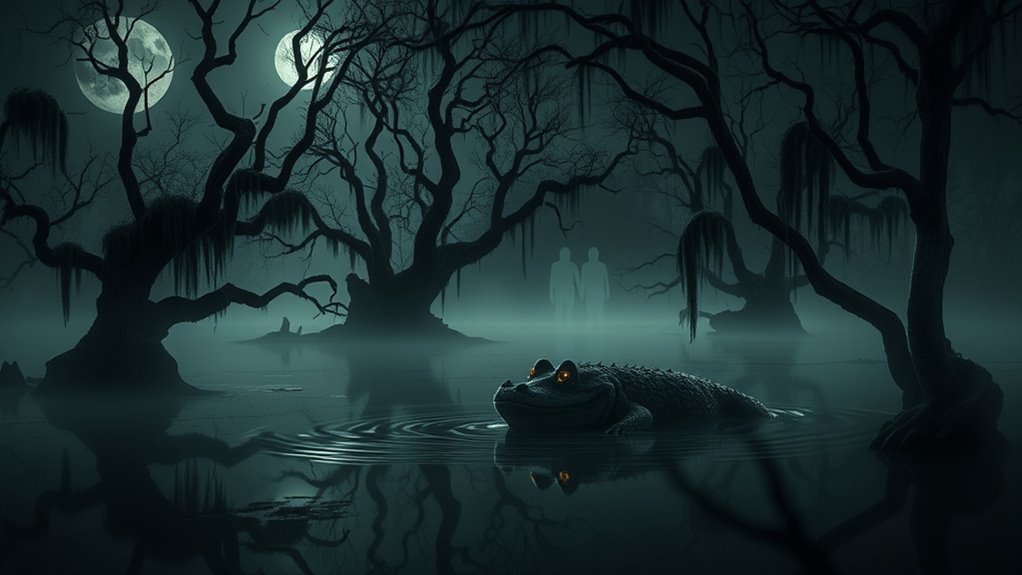In Aboriginal Australian lore, the bunyip is a mysterious water-being that embodies both fear and reverence. It inhabits waterholes, swamps, and lakes, serving as a symbol of the land’s spiritual power and ecological balance. The stories portray it as a guardian of sacred sites or a warning to respect water sources. Its legends reflect deep connections to Dreamtime, revealing important lessons about nature and cultural traditions. If you continue exploring, you’ll uncover more about its rich cultural significance.
Key Takeaways
- The bunyip is a mythical water creature central to Aboriginal Dreamtime stories, symbolizing natural mysteries and spiritual beliefs.
- Its appearance varies across regions, often depicting a fierce being with claws and teeth or a gentle water spirit.
- The bunyip serves as a cultural symbol emphasizing respect for water sources and ecological balance.
- It functions as both a guardian of sacred sites and a warning to stay cautious around water bodies.
- Bunyip legends are integral to Aboriginal cultural heritage, reflecting spiritual connections to land, water, and ancestral stories.

Have you ever wondered about the mysterious creature known as the bunyip and its place in Australian Aboriginal lore? This creature is one of the most intriguing mythical creatures in the world, and its story has been passed down through countless generations of Indigenous Australians. In Aboriginal Dreamtime stories, the bunyip is often depicted as a powerful, elusive being that inhabits swamps, billabongs, and waterholes. It’s a creature that embodies both fear and reverence, symbolizing the mysteries of the natural world and the depths of Aboriginal spiritual beliefs.
As you explore these Dreamtime stories, you’ll find that the bunyip’s origins are deeply rooted in the cultural landscape of Aboriginal Australia. These stories aren’t just tales meant to entertain; they serve as lessons, warnings, and explanations for the environment and human existence. The bunyip is often described as a creature with a mix of features—sometimes a ferocious beast with sharp claws and teeth, other times a more gentle, water-dwelling spirit. Its appearance varies across different regions and tribes, but the common thread remains: the bunyip is a creature of water, connected to the Dreamtime, the sacred era when the land and its creatures were formed.
In Aboriginal lore, mythical creatures like the bunyip are more than just stories; they’re living symbols of the landscape and its spiritual significance. The bunyip is said to lurk beneath the surface of lakes and swamps, waiting to catch the unwary. Its presence in Dreamtime stories serves as a reminder to respect the natural environment and stay cautious around water sources, which are essential for survival. These stories also reflect a deep understanding of the land’s ecosystems, emphasizing the importance of harmony between humans and nature.
Understanding the bunyip through the lens of Aboriginal Dreamtime stories offers insight into how Indigenous Australians viewed their world. It was a world filled with spirits, creatures, and sacred sites—all interconnected. The bunyip embodies the mysteries of that world, acting as both guardian and threat. Its legend continues to inspire curiosity and respect for the rich cultural traditions that have kept these stories alive for thousands of years. When you explore into the myths of the bunyip, you’re not just learning about a creature; you’re exploring a essential part of Australia’s cultural heritage and spiritual identity.
Additionally, the cookie categories used on the website help to ensure that visitors can have a tailored browsing experience while respecting privacy laws and user choices.
Frequently Asked Questions
Are There Any Recent Sightings of the Bunyip?
Recent bunyip sightings and modern encounters remain unverified, with most reports being anecdotal or speculative. You might come across stories from enthusiasts or skeptics sharing supposed sightings in remote Australian swamps or billabongs, but there’s no concrete evidence to confirm these encounters. While some believe in the bunyip’s existence, scientific investigations haven’t substantiated any recent sightings, leaving the creature’s status as a mysterious legend intact.
How Do Aboriginal Stories Differ Across Regions?
You notice that regional variations in Aboriginal stories act like different brushstrokes on a vast canvas, each reflecting unique landscapes and cultures. These stories use diverse storytelling techniques, symbolisms, and language to convey their meanings. Across regions, the tales adapt, emphasizing local wildlife, spirits, or landscapes, making each narrative a vivid mirror of the community’s environment and beliefs. This rich diversity deepens your understanding of Australia’s cultural tapestry.
What Is the Bunyip’s Role in Modern Australian Culture?
You see, the bunyip’s symbolism and cultural significance remain strong in modern Australian culture. It represents mystery and the importance of respecting nature, serving as a reminder of indigenous stories and environmental awareness. Today, you might encounter the bunyip in art, literature, and media, where it continues to evoke curiosity and preserve cultural heritage, connecting past legends with contemporary identity and values.
Are There Specific Rituals to Ward off Bunyip Encounters?
Think of warding off a bunyip as fencing off a hidden danger in a misty forest. You might use protective charms or perform ritual ceremonies to keep it at bay. These rituals often involve singing, dancing, or offering symbolic items, acting like a barrier of light. By engaging in these practices, you create a spiritual shield, helping you stay safe from the bunyip’s mysterious presence.
How Have Bunyip Legends Influenced Australian Wildlife Conservation?
You might not realize it, but the legend of the bunyip has positively influenced Australian wildlife conservation efforts. These mythical creatures symbolize the importance of protecting wetlands and native species, inspiring communities to preserve habitats and promote awareness. By recognizing the bunyip as a cultural icon, Australians foster a deeper connection to their environment, ensuring that conservation efforts respect both wildlife and cultural heritage, ultimately benefiting Australia’s unique biodiversity.
Conclusion
As you explore deeper into Aboriginal lore, the mystery of the bunyip lingers in your mind. Is it merely a legend, or does something real hide beneath the surface of the swamps and billabongs? The stories hint at secrets still waiting to be uncovered, whispering warnings and warnings you can’t ignore. Perhaps, one day, you’ll stumble upon the truth—if you’re brave enough to face what lies beneath the water’s dark reflection. The bunyip’s story isn’t over yet.










